

You might have previously read our blog on strategies for reducing hip pain in walking and running. In this new blog, we’ll be diving deep into helping you understand the causes of hip pain when walking or running. The more you understand the reasons for your hip pain in walking or hip pain in running, the closer you are to better controlling your pain.
Let’s look a bit more closely at causes of hip pain. Many of our patients who come to see us in our physiotherapy (physical therapy) clinics ask ‘Why do my hips hurt when I walk?’, or ‘Why do my hips hurt after running or walking?’ Sometimes they may have sharp pain in the hip when walking or running, or it might be more a hip ache or hip soreness after running or walking.
In this blog we are going to give you some great information on:
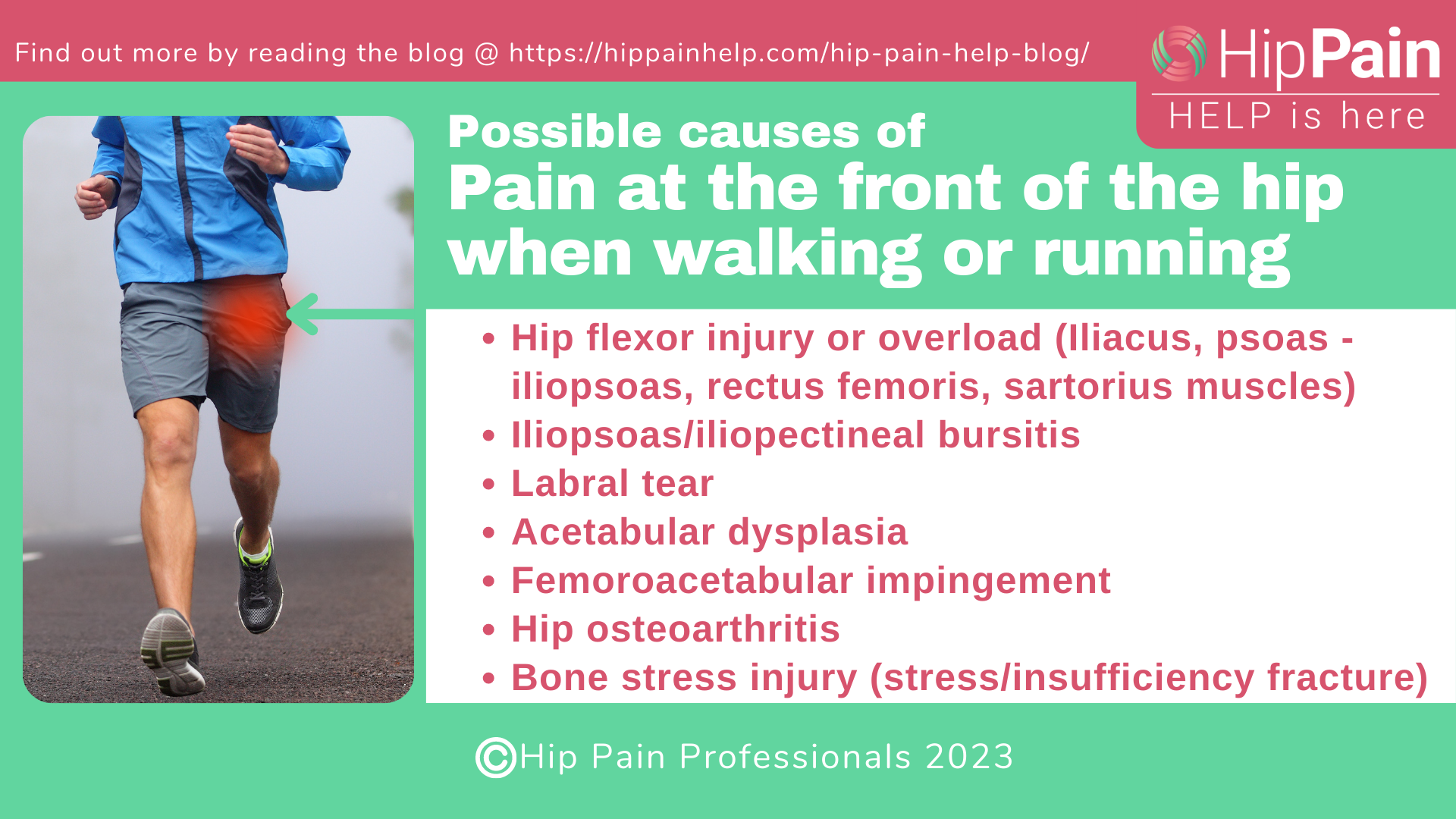
Pain at the front of the hip when walking or running may be due to the hip flexors. Your hip flexors are the muscles that run from the front of the lower spine, and pelvis, down across the front of the hip, and on to the thigh (femur).
The hip flexor muscles help to ‘flex your hip’ or lift your thigh up in front. When walking and running the hip flexors then of course play an important role to lift the thigh and repetitively swing the legs through in preparation for landing. The hip flexors also help to provide support at the front of the hip when your foot is on the ground and your body moves past your foot – when the hip moves into extension.
The hip flexor muscles include iliacus and psoas, which join into a common tendon and so are often referred to as the iliopsoas muscle. Rectus femoris and sartorius are another two of your hip flexor muscles.
Hip flexor pain when walking or running is most commonly associated with some sort of rapid change in loading. This might be related to a single incident like a strong kick or doing the splits. In this situation, your hip flexors may be painful due to a hip flexor tear, otherwise known as a hip flexor strain.
Alternatively, the change in load might not be related to a single incident, but an increase in walking or running volume or intensity – increasing walking or running distance, increasing pace of walking or running, which often involves increasing stride length, or participating in running repeats, hill sprints, bounding/stair bounding drills or similar high intensity activities.
The overloaded hip flexor muscles or tendons (referred to as hip flexor or iliopsoas tendinopathy) may become painful. The bursa (flat fluid filled sack) that sits beneath the hip flexors may also become painful and is known as iliopsoas bursitis.
You can read more about hip flexor pain by clicking on the bolded text in this sentence.
Trying the 3 strategies listed in our free download is a great place to start in relieving your hip pain in running or walking.
Longer strides can result in excessive use of the muscles through a large range of movement which may be painful. When you push off in running and walking, the hip flexors need to absorb the hip forces at the front of the hip. Overstriding (taking an excessively long stride) will just magnify the work that the hip flexors need to do. Reducing your step length will immediately reduce the load on the hip flexors.
Unfortunately, most people assume hip flexor pain in walking or running is due to hip flexor tightness and start doing a lot of strong hip flexor stretching. This is rarely the main issue and while the stretching may provide a very short-term feeling of relief, it doesn’t solve the underlying issue around the reason for muscle and tendon overload and may even make the situation worse.
So, if you think you have hip flexor related pain during or after walking or running:
Although the hip flexors get blamed for most pain at the front of the hip when walking or running, if your pain is not settling, it is much more likely to be related to the underlying hip joint.
One of the most common joint structures that can cause pain at the front of the hip walking or running, is the acetabular labrum. The hip labrum is the fibrous cartilage that sits around the edge of the bony hip socket, like a fringe. Changes within this labrum, including a labral tear, can cause pain at the front of the hip walking and running.
Labral tears are commonly associated with acetabular dysplasia – hip dysplasia (a shallow hip socket), or femoroacetabular impingement – hip impingement.
The joint structures at the front of the hip, including the labrum, are under most load at the end of the stance phase, towards foot push off. Overstriding (taking really large strides) when walking or running, increases this load even more. If you have some labral degeneration or a labral tear, overstriding or a rapid increase in walking or running, or tackling more challenging terrains may result in the joint become irritated and painful.
The hip flexors may increase their activity to try to protect the underlying joint structures – this is why the hip flexors often get blamed for pain at the front of the hip. However, their response is a result rather than the cause of the hip pain, and lots of vigorous hip flexor stretching is likely to further irritate the unhappy joint structures.
So, if you think you have hip pain when walking or running related to a labral tear:
People with hip osteoarthritis, the most common form of arthritis, often experience pain in their hip joint running or walking. Hip osteoarthritis is a hip joint condition, involving inflammation and gradual thinning of the smooth cartilage surfaces of the ball-and-socket joint.
Most people think that because running and walking are higher impact activities, they may be the cause of hip osteoarthritis, or might cause progression of the condition once it is present. There is in fact no good evidence of that, and actually suggestions to the contrary.
Osteoarthritis is a multifactorial condition, with certain types of physical loading only one potential factor. Physical loading is incredibly important as a positive stimulus for health of our body, including our joints, bones and surrounding muscles.
So, don’t stop exercises when you have hip osteoarthritis, but gradually increase activity levels, allowing time for the body to adapt – avoid the ‘too-much-too-soon’ trap, often also referred to as ‘boom-bust’.
Increase activity slowly, monitor your response to activity and adapt accordingly. The ‘Traffic Light Approach’ is a good way to monitor and progress your activity.
The 3 strategies we outline in our free download are helpful for those with hip osteoarthritis – helping you reduce any irritating loads placed across the joint when walking and running with large strides, landing too heavily, or tackling more challenging terrain.
So, if you have hip pain in walking or running with osteoarthritis:
Read more about best exercise for hip osteoarthritis by clicking on the coloured text in this sentence.
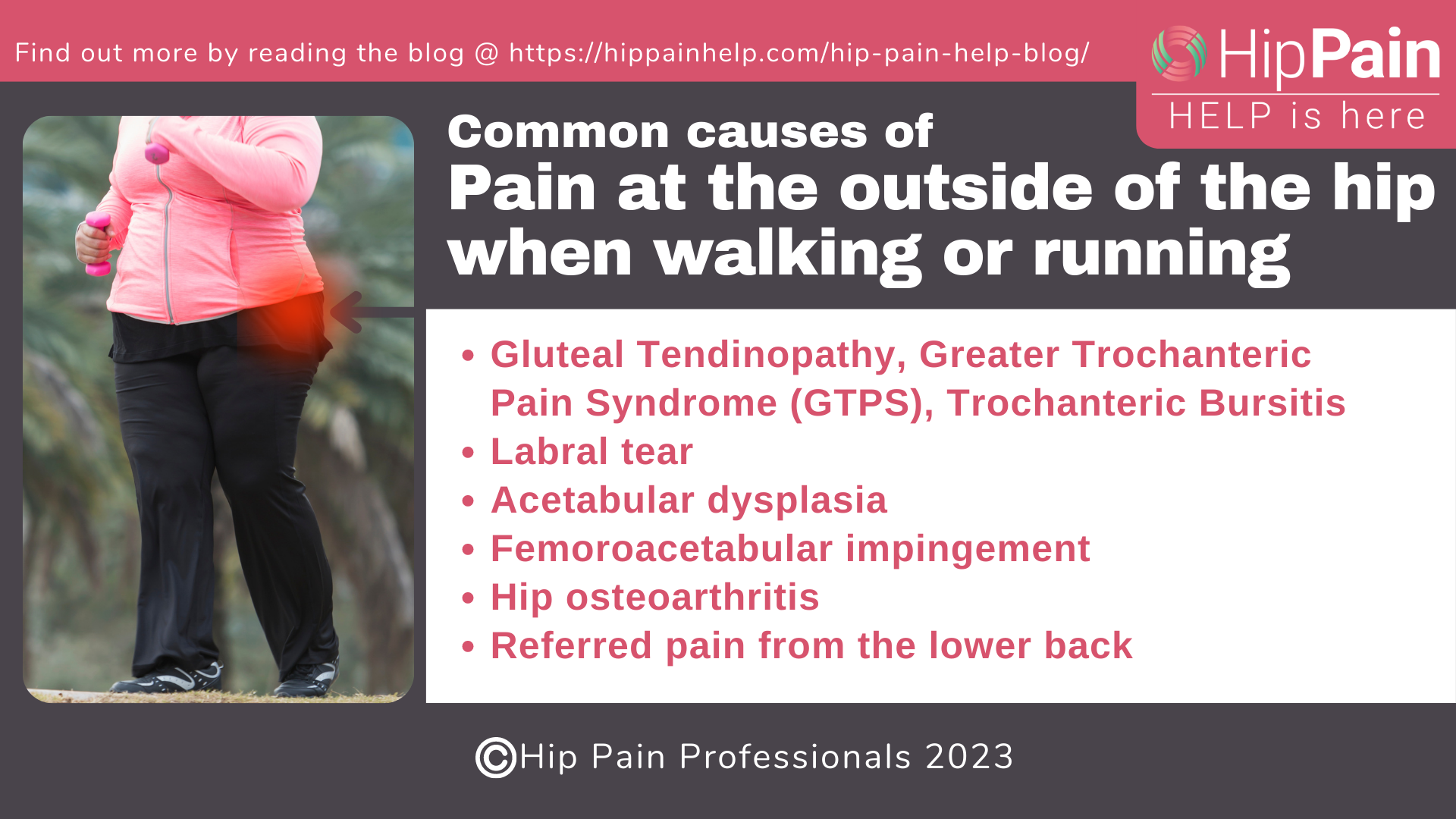
These conditions are all interlinked. Pain over the side of the hip is commonly related to changes in the health of the tendons that join the gluteal (buttock) muscles to the hip, and sometimes of the nearby bursae (fluid filled sacks that help reduce friction between tendons and bones). The condition may be diagnosed as gluteal tendinopathy or tendinitis, trochanteric bursitis or Greater Trochanteric Pain Syndrome (GTPS) which encompasses both.
Researchers have shown that people with gluteal tendinopathy tend to walk in ways that overload the tendons and bursae at the side of their hips (Allison et al., 2016). One of the things that contributes most strongly to these hip loads, is the way people control their trunk and pelvis when they walk or run.
Excessive sideways pelvic tilt (lateral pelvic tilt) or sideways body lean increase the loads at the side of the hip (Allison et al., 2016). These movement patterns might be habitual or related to muscle weakness or lack of endurance. People with gluteal tendinopathy and pain at the side of their hip in walking or running, have been shown to be weaker in their gluteal muscles than people without pain. Allison et al 2
Other factors that can contribute to gluteal tendinopathy or hip bursitis pain in walking or running:
A physical therapist/physiotherapist can perform a walking or running assessment to assess how your move, and if this may be relevant to your hip pain. They can provide individualised advice around how to reduce your hip pain in walking or running and build you an exercise program to address any underlying factors such as gluteal weakness.
You can visit our directory of health professionals with an interest in hip pain by clicking on the coloured text in this sentence.
Other causes of pain at the side of the hip when walking or running
While gluteal tendinopathy or GTPS is the most common cause of lateral hip pain – pain on the outer side of the hip when walking or running, there are other possible causes. GTPS is usually experienced right over the greater trochanter (the bone that sticks out the side of your hip) and may travel down the outer thigh towards the knee.
If the pain is a little higher – between the greater trochanter and the iliac crest (the top of the pelvis), the most common sources are likely to be within the hip joint, associated with labral tear, acetabular dysplasia, femoroacetabular impingement or hip osteoarthritis.
If the pain extends from your lower back or buttock, runs across the side of the hip and then down towards the lower leg or foot, it is most likely that you have referred hip pain from the lower back.
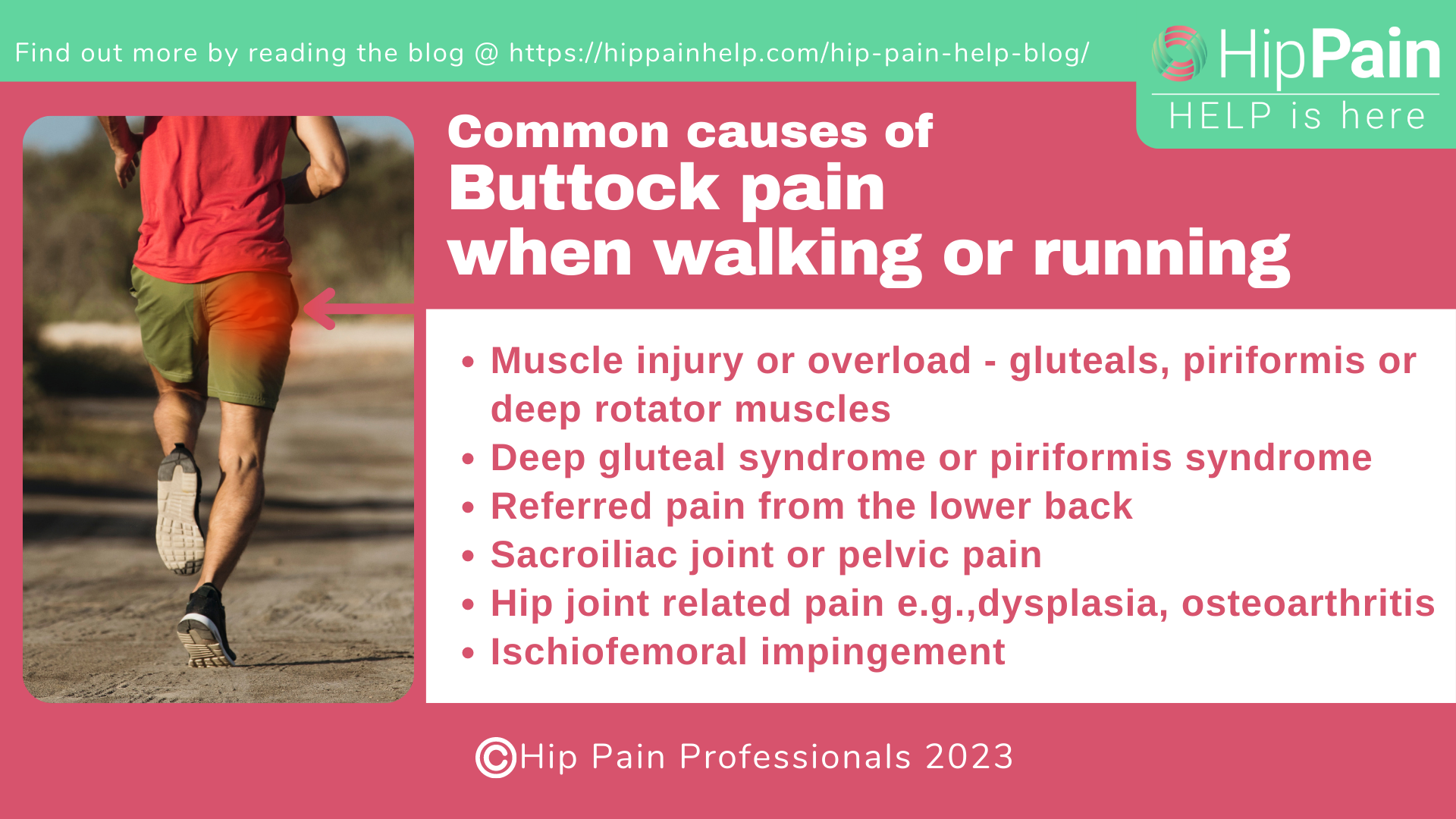
Pain in the buttock when walking or running may be simply gluteal or ‘glute muscle’ pain. Some of the other deeper buttock muscles – the piriformis and deep external rotators may also become overloaded and sore. Muscle pain is most commonly due to pushing the muscle past its capacity and not allowing adequate time for recovery.
For example, if you suddenly take up hill sprints or a hard new glute exercise in the gym, it is likely that you will develop some delayed onset muscle soreness in the next day or so. This is not dangerous and will settle with adequate recovery, for example just sticking to light activity or some swimming or pool recovery for a couple of days.
However, if you try to run the next day, you might add to the overload on the muscle and delay its ability to recover.
To avoid glute pain during or after running or walking:
If you are following these guidelines and you are still experiencing glute pain running or walking, chances are there is something else going on. Read on to find out other causes of buttock pain when walking or running.
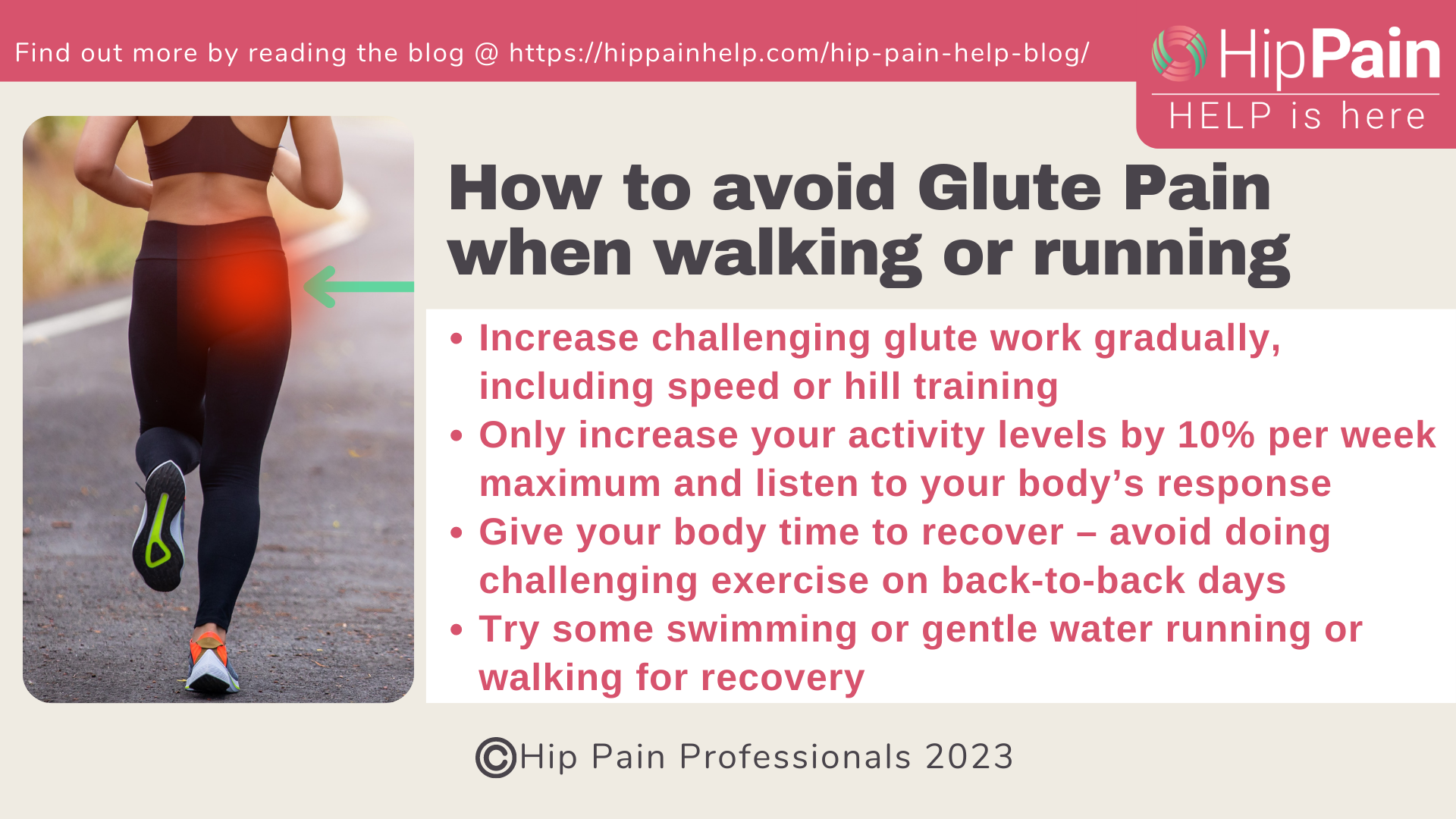
Buttock pain that you feel in walking and running and that often becomes a problem in sitting, could be related to irritation of the sciatic nerve as it runs through the buttock – this is usually referred to as Piriformis Syndrome or Deep Gluteal Syndrome.
The sciatic nerve is a large, thick nerve that comes together in the pelvis from nerve roots that exit from the lower back. The nerve travels out the back of the pelvis and deep through the buttock, on its journey to the thigh, lower leg and foot. When the nerve is irritated deep in the buttock area, it is called Deep Gluteal Syndrome or Piriformis Syndrome. When the sciatic nerve causes hip pain running or walking, this is usually felt through the back of the hip in the buttock, and frequently travels down the back of the leg.
This diagnosis is often missed, as it is usually assumed that the pain is coming from the lower back. This may result in much wasted time and money having treatment that is unsuccessful. If you have already had your back checked out and nothing can be found, or you might have had treatment for your back with minimal response, it might be worth considering Deep Gluteal Syndrome.
You may want to check out our Recovering from Piriformis Syndrome Self Help Program. Our first lesson is completely free and will help you understand more about what this condition is and its symptoms, as well as take you through some quick self-assessment tests. You can then decide whether your symptoms might be from irritation of the sciatic nerve in the buttock, and whether our course might be helpful for you.
Avoiding overstriding and softening your landing can reduce buttock pain in walking when walking or running. Harsh striking a long way in front of your body, results in a high peak of activation of the muscles deep in the buttock. Rapid, repetitive, forceful contractions of these deep muscles around the sciatic nerve, may irritate pain associated with deep gluteal syndrome. Read more about these simple strategies in our free download on reducing hip pain in walking and running.
One of the most common causes of buttock pain generally, is pain referred from the lower pain. This might be due to irritation of the nerve roots that exit the spine – this is referred to as radicular pain. Other structures in the lower back such as the facet joints and discs can also refer pain to the buttock – this is known as somatic referred pain.
Back referred buttock pain can be aggravated by walking and running due to the impact of landing, and sometimes the range of motion. Once again, large strides and heavy impact can be irritating. If you happen to have tight hip flexors, these large strides might transfer into increased extension (arching) and/or rotation of the lower back. If your back is already a little sore, or you are running or walking for longer distances, these factors can aggravate buttock pain related to your back.
Try strategies 1 and 2 in our free download, to reduce back referred buttock pain in walking and running, and if you get more pain after walking or running hills, try strategy 3 for a while as well. Link to the download page
Buttock pain during walking or running may also come from the sacroiliac joints, the joints on either side of the sacrum (tailbone). This is often referred to as pelvic pain, posterior pelvic pain (posterior just meaning ‘back’ of the pelvis), pelvic girdle pain, or sacroiliac joint pain.
Posterior pelvic pain in running or walking is usually felt around the sacrum – either side of the sacrum or sometimes the whole sacral area will ache during or after walking or running. Pain may also extend into the lower back and down from the sacrum into the saddle area and even into the groin.
Pelvic girdle pain is most common in women during or after pregnancy and childbirth – pregnancy related pelvic girdle pain . During pregnancy, the hormone ‘relaxin’ relaxes the ligaments of the pelvis in preparation for childbirth. If the supporting muscles are not adequate to control this increased mobility during walking or running, you may begin to experience some buttock pain in the sacroiliac joint region.
The ligaments tighten up again gradually after childbirth, but in the meantime, controlling pregnancy related buttock pain might require some activity modification to reduce loads temporarily, and an exercise program to improve muscle support of the sacroiliac joints.
Sacroiliac joint pain when walking or running may also occur in people who have had some trauma to the pelvis or tailbone (e.g., a falls onto the buttocks or into the splits), or who are hypermobile.
As discussed in the 3 top strategies in our free download, reducing stride length and landing more softly when walking or running can be very helpful in reducing the forces crossing the pelvis. Walking or running stairs and hill climbing can also be aggravating, due to the forward body position and greater effort required to push the body up against gravity.
While hip joint related pain is most commonly felt at the front of the hip and groin, it can also present deep in the mid buttock region. Buttock pain during walking or running may be related to hip joint osteoarthritis, or hip instability or hip impingement at the back of the joint.
Impingement of one of the deep hip rotators, quadratus femoris, may also occur between the femur and the pelvis during walking and running, resulting in pain in the lower buttock. This is called ischiofemoral impingement.
Lower buttock pain in walking or running that is related to ischiofemoral impingement or impingement within the hip joint is usually experienced as you step past your leg, into the push-off phase.
Buttock pain in running or walking that is related to hip osteoarthritis or hip instability (possibly due to hip dysplasia) is more often felt as the heel hits the ground, or in the early loading phase of the walking cycle.
All of these conditions are potentially aggravated by excessively long strides and/or heavy impacts, so strategies 1 and 2 in our free download will be once again useful to manage pain. You may also need to seek the assistance of a health professional that knows hips, to provide individualised training in walking/running technique, advice on training habits, and an exercise program.
We hope you’ve found this blog helpful, and now have a better awareness of causes of hip pain when walking or running. If you haven’t already, don’t forget to pick up your free download that we put together for you: 3 Simple Strategies to Reduce Pain with Walking and Running.
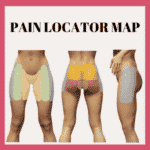
Visit our Pain Locator Map to learn more about pain in different regions around the hip and pelvis.
This blog was written by Dr. Alison Grimaldi, with contribution from one of our Hip Pain Professionals, Kirsty McNab, experienced physiotherapist.
Dr. Alison Grimaldi is a globally recognised expert physiotherapist, researcher, and educator, who has over 30 years professional clinical experience helping patients recover from a wide range of hip and pelvic conditions.

Dr. Alison Grimaldi BPhty, MPhty(Sports), PhD, FACP
Dr Grimaldi has completed Bachelor of Physiotherapy, Master of Physiotherapy and Doctor of Philosophy (Physiotherapy) degrees. She is a fellow of the Australian College of Physiotherapists, Practice Principal of PhysioTec Physiotherapy, an Australian Sports Physiotherapist , an Adjunct Senior Research Fellow at the University of Queensland, as well as an author and global educator. Her passion is helping people with hip pain, and educating other health professionals around how to help more people with hip pain.
